Littering is a problem and seems to be getting worse according to much of what I’ve read and observed.
The Problem
According to Keep America Beautiful ( a non profit organization : https://kab.org/ ) the USA spends about $11 billion per year to clean up litter and the pandemic is making it worse.
Cigarettes are a big part of that litter. They start fires when flicked out of car windows and even when they don’t their filters are packed with non-biodegradable plastics that make 1.69 billion pounds of toxic litter every year. Cigarette butts account for more than one-third of all litter collected.
According to the Truth Initiative, smokers litter 4.5 trillion butts every single year. The 4,000-plus cancer-causing chemicals found in cigarettes — including arsenic, the key ingredient in rat poison — leach into the soil and water.
An increase of single use plastics are also to blame. Single use masks have increased significantly in relationships to the rise in COVID and hospitals are dumping more single use medical waste daily. Additionally, due to the lockdowns plastics like containers and bubble wrap increased and account for additional waste introduced into the environment.
I personally have seen single use masks littered around my house; an action that is not only increasing waste and cost but also could be increasing public health risk.
What trash is littered?
So we’re now aware of the issue superficially. Let’s take a step back and analyze the problem.
How do you define trash? Trash is discarded matter or refuse.
Trash that people discard in the environment is litter.
How does litter accumulate? People throw trash while they are walking, from when they drive cars, it could be thrown from their house, or overflow from trash bins.
What are some litter types?
- Common:
- Cans
- Plastic bottles
- Paper
- Liquids
- Less Common:
- Electronics
- Furniture
- Fabric
- Hazardous material
What are some examples?
This is a personal problem for me because I see it all around my house and once I’ve started looking I’m seeing it everywhere I go.
I recently walked two blocks near by my house and picked up a full bag of litter. I was a little surprised how much I found actually.
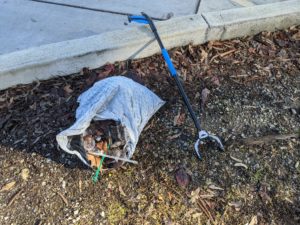
I notice that there is litter mostly on streets, sidewalks, trails, highways, freeways, and accumulation around gas stations.
These are just a few images of where trash accumulates but I’ll be updating this post regularly with some more egregious examples that I’ve observed but not documented.
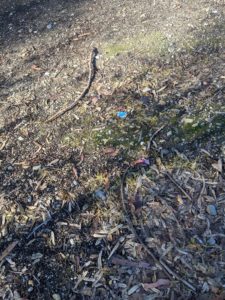
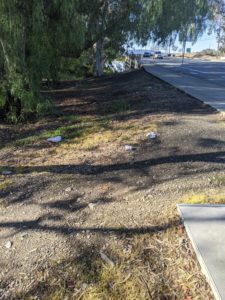
You’ll notice that the litter is embedded in leaves and dirt which can make it a little difficult to retrieve.
Further from experience picking litter with current manual methods is a slow and inefficient process. Additionally, there is only so long that a person could or would want to pick trash for. In this instance it took me about an hour going only a few blocks to fill up a trash bag of litter and that only mostly cleaned up my target area. My other observation is that the private areas don’t have quite as much trash as public areas. People clean the area around their houses for the most part and businesses keep their area clean (aside from parking lots). The areas that are most problematic are the public ones (streets, sidewalks, trails, and parking lots) which I would infer are generally city regulated. Volunteers only won’t and currently isn’t solving this problem. We need better tools and technology to move these tasks from laborious, repetitive, slow, and manual to fast and automated.
In an ideal world we’d find a solution to stop the litter from happening in the first place, but as a first step we need to clean up the litter that already exists and create a process to clean routinely. Then after that we’ll work towards prevention.
What is done with trash today?
Even if the trash is properly disposed of we don’t really have great solutions for what to do with it. If costs are not too high and manufactures will pay for them items can be recycled. If not recycled then they just go to land fills. The trash could be burned or offloaded to other countries. Or worse nothing is done with it and it just sits.
What are some items that can be recycled?
Paper can be recycled based on different grades. The recycling process is surprisingly easy to do at home and includes:
- Shred the paper
- Clean
- Bleach
- Blend
- Filter mixture on a wire frame
- Iron
Having the expertise to sort based on grade is important and the costs to run this at scale are a question. However, the process is straight forward.
On average you can sell paper for $50 to $70 per ton. So, the only way that this is possible is to sell in bulk. However, if you run a business you could save costs (albeit marginal) by recycling and reusing your own paper as well as litter accumulated.
Plastics can be recycled. Here’s the process:
- Material Collection
- Sort and Categorize
- Washing
- Shredding
- Identification and Separation
- Extruding and Compounding
See this link for more details: https://www.rts.com/blog/the-complete-plastics-recycling-process-rts/
Once the materials are Individuals can create 3d printer filament out of plastics ( albeit I’m not sure if those are plastics like those found in bottles that you would find in litter or different types)
Aluminum.
Other metals and be melted down and reused.
Food could be composted.
There are likely ways too that most trash could be reformed. That said, some hazardous material either from chemicals or electronic components seem to not be. It may be a good idea to research this further to determine what is done in these scenarios today.
Enough Incentive to Solve the Problem?
Even though littering is a problem that seems to be growing bigger there are many incentives to solve it.
Unless there is an incentive solving and managing this problem is unlikely.
Parking Lots
Find a commercial real estate company in your local community and you can make $30 to $50 per hour just picking up trash in a parking lot.
Additionally, clearing leaves and yard waste may be a supplementary service.
Adopt-a-Highway
Additionally, you can adopt a highway to earn revenue.
Whether Adopt-a-Highway participants clean up litteras individuals or in a group, they can earn up to $250 through the new Clean California pilot program.
“Since July, Caltrans has collected nearly 2,500 tons of trash and made more than 600 conditional job offers as part of the program,” Caltrans boasted about the program in a news release.
To take advantage of this opportunity call 866-ADOPTAHWY (886-236-7824) or apply online at CleanCA.com.
Counties where you can clean up:
- Butte
- Colusa
- El Dorado
- Glenn
- Imperial
- Nevada
- Placer
- Sacramento
- San Diego
- Sierra
- Sutter
- Yolo
- Yuba
City Contract
Another idea is to talk to the city about cleaning trash or picking up leaves on the side of highways.
Consider going around a particular city and capture pictures in problem area. Next, create a presentation that highlight the macro problem, specific problem in targeted areas, the cost and time for the alternatives, then make a pitch to solve this problem.
Once collected then the litter can then be sorted in to trash and recycling. The recycling can be sold to manufacturers to be reused. Or, you could reuse it yourself for 3D filament and then build products or additional robots.
A New Vision
So, that’s the cleanup part. I recently have an idea to create a completely vertically integrated company that collects litter and materials from landfills, recycles it, manufactures products, and then sells those products. The main barriers are the costs to recycle and manufacture. However, if you can get those costs down sufficiently then it could be a competitive advantage as you’re essentially getting free inputs which should theoretically reduce your cost of goods sold.
This completely self sustainable and vertically integrated model could be used on Mars or the Moon if we ever get there.
Here’s a high level of what this model could look like. Additional thought must go into making the individual steps more efficient and low cost but the general idea seems straight forward enough.
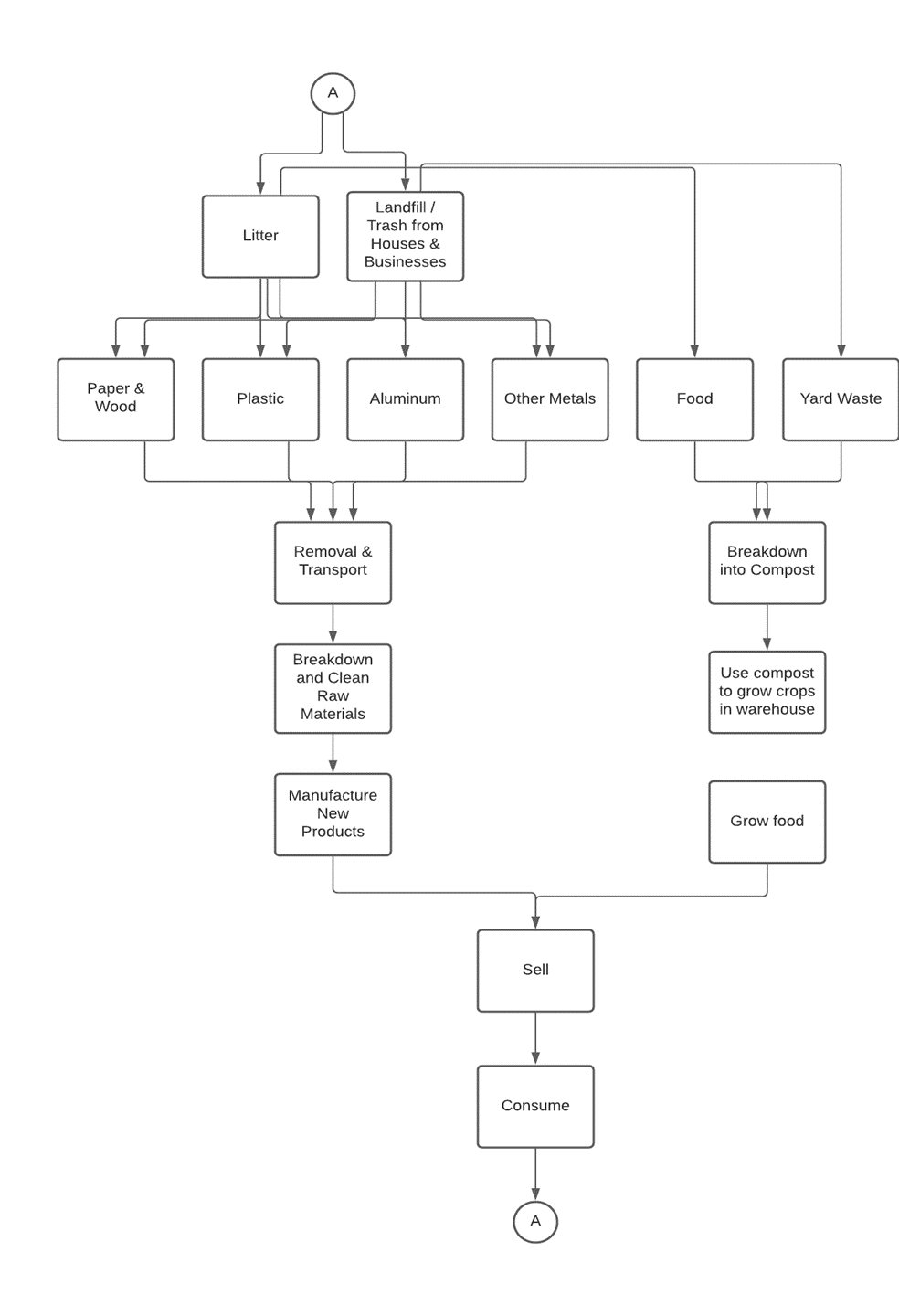
In Conclusion . . .
Litter is a problem and we all need to put our heads together to figure out how to solve it. We need a reciprocal approach to incentive private organizations and citizens to solve this. Otherwise, we’ll continue to see this problem inconsistently addressed or not addressed at all – with the latter seeming to be the current state. We can do it but it will take some iteration and persistence.

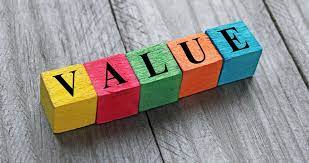
One thought on “Littering”